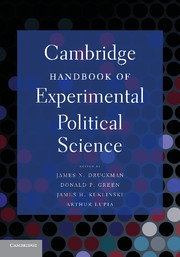Book contents
- Frontmatter
- Contents
- List of Tables
- List of Figures
- Contributors
- Acknowledgments
- INTRODUCTION
- PART I DESIGNING EXPERIMENTS
- PART II THE DEVELOPMENT OF EXPERIMENTS IN POLITICAL SCIENCE
- PART III DECISION MAKING
- PART IV VOTE CHOICE, CANDIDATE EVALUATIONS, AND TURNOUT
- 13 Candidate Impressions and Evaluations
- 14 Media and Politics
- 15 Candidate Advertisements
- 16 Voter Mobilization
- PART V INTERPERSONAL RELATIONS
- PART VI IDENTITY, ETHNICITY, AND POLITICS
- PART VII INSTITUTIONS AND BEHAVIOR
- PART VIII ELITE BARGAINING
- PART IX ADVANCED EXPERIMENTAL METHODS
- AFTERWORD
- Name Index
- Subject Index
- References
15 - Candidate Advertisements
Published online by Cambridge University Press: 05 June 2012
- Frontmatter
- Contents
- List of Tables
- List of Figures
- Contributors
- Acknowledgments
- INTRODUCTION
- PART I DESIGNING EXPERIMENTS
- PART II THE DEVELOPMENT OF EXPERIMENTS IN POLITICAL SCIENCE
- PART III DECISION MAKING
- PART IV VOTE CHOICE, CANDIDATE EVALUATIONS, AND TURNOUT
- 13 Candidate Impressions and Evaluations
- 14 Media and Politics
- 15 Candidate Advertisements
- 16 Voter Mobilization
- PART V INTERPERSONAL RELATIONS
- PART VI IDENTITY, ETHNICITY, AND POLITICS
- PART VII INSTITUTIONS AND BEHAVIOR
- PART VIII ELITE BARGAINING
- PART IX ADVANCED EXPERIMENTAL METHODS
- AFTERWORD
- Name Index
- Subject Index
- References
Summary
Nowhere can democracy be better seen “in action” than during political campaigns. As Lau and Pomper (2002) argue, “Democracy is a dialogue between putative leaders and citizens. Campaigns provide the most obvious and the loudest forums for this dialogue. Candidates try to persuade voters to cast a ballot and to support their cause. Voters respond by coming to the polls and selecting their preferred candidates” (47). Candidates make their arguments in speeches at campaign rallies and on their Web sites, but those venues are primarily experienced by the most committed of partisans. It is only through their campaign advertisements that candidates have any chance of reaching uncommitted voters. And in times of even very approximate party balance, it is uncommitted voters who usually determine election outcomes. Hence, political ads are arguably the vehicle through which democracy operates.
Consider the choices facing a political candidate at the outset of a democratic election campaign. To simplify, let us assume a candidate's goal is to win the election, but he or she is facing one or more opponents who have the same goal and therefore want to defeat him or her. All candidates must decide what strategy to follow in order to maximize their chances of winning. But all candidates face resource limits that put very real constraints on what it is possible to do. Therein lies the rub. Candidates must decide how they can get the biggest bang for their buck.
- Type
- Chapter
- Information
- Cambridge Handbook of Experimental Political Science , pp. 214 - 227Publisher: Cambridge University PressPrint publication year: 2011
References
- 8
- Cited by

